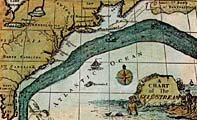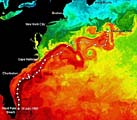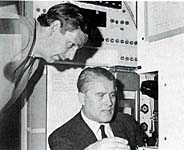From Sea to Shining Sea:
A Film Treatment by Paul Gasek and Gene Carl Feldman
NASA imagery of the Gulf Stream; time lapse temperature maps and other descriptive graphic images of the projected drift course.
Once the sub has entered the Gulf Stream and begins to drift, the plan is to begin continuous measurements of drift speed, water temperature, salinity, marine life in the stream, and conduct stereo-photo mapping of the Continental Shelf. It will also carry out underwater acoustic experiments, as well as record magnetic anomalies along the drift track. The result will be a detailed profile of the Gulf Stream gathered from the very heart of it. It will be the first mission of its kind in the world, riding a building wave of public awareness of the oceans fostered by Jacques Cousteau and others.

![]()

![]()

Historical: portraits of the Franklin crew.
Original: interviews with surviving crewmen.
A crew of six is carefully chosen. Piccard is the mission leader; Erwin Aebersold, another Swiss, is Piccard’s handpicked pilot and main assistant to Piccard and project engineer during the Franklin's design and construction. Grumman taps a Navy submariner named Don Kazimir to be captain. The U.S. Navy Oceanographic Office sends Frank Busby to conduct a bottom survey along the drift track over the Continental Shelf; the Royal Navy sends Ken Haigh, an acoustic specialist, who will study underwater acoustics and run sonic experiments up and down the water column throughout the mission.

Historical: focus on Chet May.
Original: interview with Chet May.
The sixth man is Chet May. As early as 1967, NASA establishes a Space Station Office and begins to study the feasibility of humans living in space, in completely contained environments, for prolonged periods. May is a NASA scientist; his specialty is ‘man working in space.’ Werner von Braun hears about the Franklin mission, visits the sub in Palm Beach, and considers the mission a kind of analogue to a prolonged mission in space. He appoints May as a NASA observer to accompany the mission and study the effects of prolonged isolation on the human crew.

![]()

![]()

PREVIOUS PAGE | Page 4 | NEXT PAGE